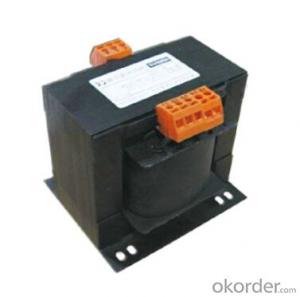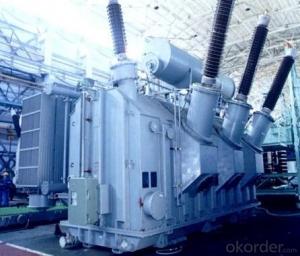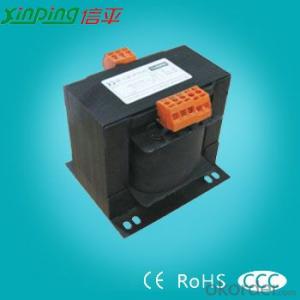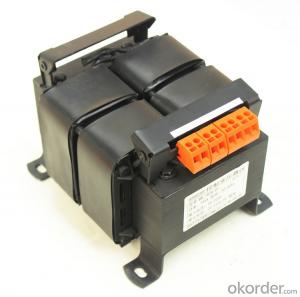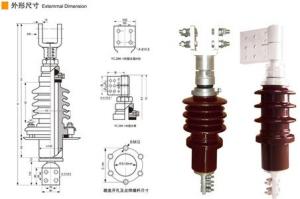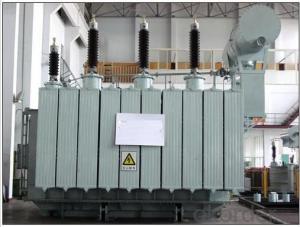jbk high voltage transformer power transformer
- Loading Port:
- Tianjin
- Payment Terms:
- TT OR LC
- Min Order Qty:
- 1 unit
- Supply Capability:
- 500 unit/month
OKorder Service Pledge
OKorder Financial Service
You Might Also Like
Scope of application
The transformers are applicable to AC50-60HZ circuits,it could be widely used on control power supply for mechanical equipments such an bridge crane,ship,wind power generation,photovoltaic power generation,testing machines,local lighting,signal lamps and others.
Characteristics
It has charachteristics of excellent performance,reliable operation,low energy consumption,small volume,safe wiring and wide application,and as it can work for a long term under rated load,it is an ideal variable voltage power supply.
Overall and installation dimension

Specifications


About us
The main products include different kinds of transformer ,such as EI transformer,encapsulated transformer ,switch power supply transformer,inducatance transformer,BK&JBK transformer,toroidal transformer,intelligent servo transformer,three-phase dry type transformer,QZB transformer,special transformer and others.
We does a lot of tests during design,developing and the application of raw material and uses high quality raw material fianlly.So the transformer has the advantages of low no-load loss,high efficiency and low temperature rise.It has been widely used in household appliances,intelligent meters,solar meters,solar meters,automatic equipment,special equipment and others.
In the process of manufacturing and business,We always sticks to the principle of honoring contract,keeping credit,complying with business ethics and seeking the perfect quality.Being the leader of transformer and electronic components industry is the development goal .Comparing price under the same quality and comparing quality&service under the same price is the business concept .Devoting of your requirement,We will supply you excellent service from products concept to designing,sample making,confirmation,producing,testing and delivering.We would like to cooperte with you and build a bright future together.
- Q: if the transformer converts 240v ac to 8V ac, ratio 30:1 then it should step up the voltage by the same ratio, i.e, 15V ac to 450v ac.but it's not the case !!
- It must be using different terminals for step up and step down.
- Q: I know that before the 2007 release of transformers and this years sequel there were various animated tv series and comics. I just want to know what the live action movies are actually based on. Like are the movies just real life portrayls of the the animated story line? Or are they original plots just based on the ideas of autobots, decpticons and there home cybertron?If the plots for the movies are based off the comics of series (like the x men movies) what could be the possible plot for the 3rd installment of the film franchise?
- toys/cartoons
- Q: i heard that there is a new transformers out and i do not know if it is good,so can you help?
- My rate: 5 out of 10
- Q: i have the 240V AC to 12V AC step down transformerwhen i connecting directly to 240V line the output is higher at about 16Vi need only 12V for my circuithow to get the exact amount of output voltage?
- you have a 1/20 step down transformer that is broken,you should try another trans and see what happens or try 220 witch is the reel voltage/20 maybe you get 10v if your lucky at the end
- Q: I use transformers in my circuitry all the time but when a transformer is say a secondary 12v 1a transformer than what does it mean by 1 ampis it that the secondary winding wire will pop after 1 amp doo to the simple thinness of the wire? or that the ohms of the secondary coil, when using iv/r, 112/12so does this tell you that the coil is 12 ohms?please don't give me other information about the transformer just answer the question please.
- It means the transformer secondary voltage is 12 volts and the current rating is 1 amp. If you put a higher current load on the transformer it won't pop, but it will overheat and the insulation will degrade faster than if the current was kept below 1 amp. If the current is allowed to go too high, the transformer will fail in a short time.
- Q: how low voltage smelting transformer can be modified to a higher voltage to be used in ferronickel production
- You need to provide more information about the original use of the transformer. Nickel smelting is a very specialized application that calls for a 'submerged arc'. Basically, the arc is fairly short and will essentially be submerged in a layer of slag on top of the molten material. It is a semi-continuous process in that periodically, some of molten nickel is poured off. The stream of molten nickel is blasted with water that causes the nickel to solidify into small pellets. Steel melting furnaces, by contrast, involve a much longer arc. The slag layer in the furnace is much thinner, and much of the arc is above the slag. It is a batch process in that once the 'campaign' has been completed, the entire melt is 'tapped' - poured into a tundish either to be cast into ingots or to feed a continuous casting process to make billets, slabs or even plates. There are other smelting processes for other materials - for example, silicon is produced via a smelting process. I would guess that if the voltage requirements of the nickel smelting process are different from the requirements of the original utilization, then it would be necessary that the transformer be redesigned and rewound - something that I would not expect to be very practical.
- Q: And what are the prospects for Transformers 3? I mean, should i just skip it?I forced myself to watch Transformers Twice. Didnt care for it much, either time. Barely, BARELY passable.
- Hollywood EF'ed up the first one to make the second one
- Q: What is the role of the pebbles in the transformer base
- Shandong Yi River Pebble Factory ---- Transformer dedicated pebble production suppliers.
- Q: What is an isolated ring transformer?
- Isolated ring-type transformer is mainly focused on its insulation performance, between the primary and secondary must have a double insulation, so that the isolation of its own high efficiency, effective protection of equipment safety.
- Q: If a typical class 2 transformer is rated at 40 va.what is its true power rating(purely resistive load)and how is it calculated? Thx
- If the load is purely resistive then the power factor is 1. This is because the true power is equal to the apparent power. The reason the true power is not always the same as the apparent power is because the load may be either capacitive or inductive. This causes the phase of the current waveform to be either leading or lagging compared to the voltage waveform. Power is still the voltage times the current but since they are out of sync if you slice up the waveform into small segments and do the calculation for each slice and the average them all together the real power is less then the apparent power. The apparent power is the the product of the rms voltage and the rms current. The answer to your question is that the true power rating is the same as the apparent power rating. It is not calculated because by definition if the load is purely resistive the true power rating is the same as the apparent power rating. I hope this helps.
Send your message to us
jbk high voltage transformer power transformer
- Loading Port:
- Tianjin
- Payment Terms:
- TT OR LC
- Min Order Qty:
- 1 unit
- Supply Capability:
- 500 unit/month
OKorder Service Pledge
OKorder Financial Service
Similar products
Hot products
Hot Searches
Related keywords
